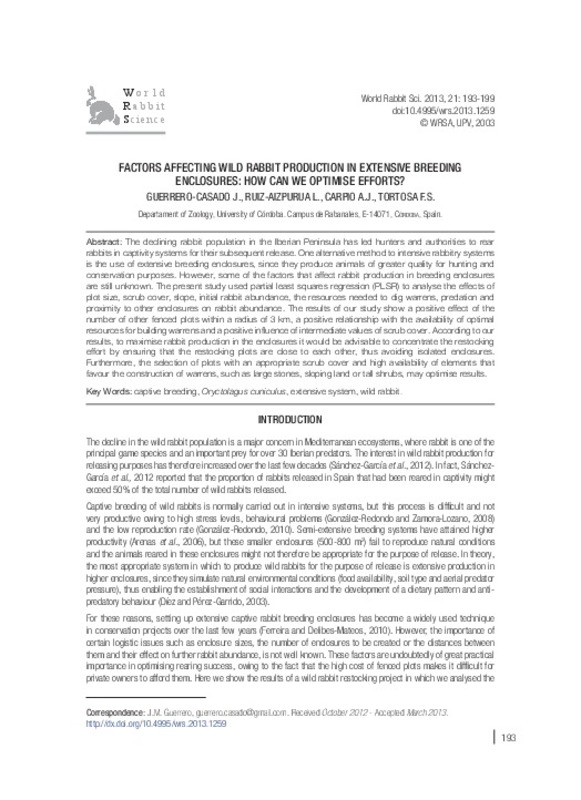JavaScript is disabled for your browser. Some features of this site may not work without it.
Buscar en RiuNet
Listar
Mi cuenta
Estadísticas
Ayuda RiuNet
Admin. UPV
Factors affecting wild rabbit production in extensive breeding enclosures: how can we optimise efforts?
Mostrar el registro sencillo del ítem
Ficheros en el ítem
| dc.contributor.author | Guerrero-Casado, José
|
es_ES |
| dc.contributor.author | Ruiz-Aizpurua, Leire
|
es_ES |
| dc.contributor.author | Carpio, Antonio J.
|
es_ES |
| dc.contributor.author | Tortosa, Francisco S.
|
es_ES |
| dc.date.accessioned | 2013-10-14T15:19:00Z | |
| dc.date.available | 2013-10-14T15:19:00Z | |
| dc.date.issued | 2013-10-01 | |
| dc.identifier.issn | 1257-5011 | |
| dc.identifier.uri | http://hdl.handle.net/10251/32820 | |
| dc.description.abstract | [EN] The declining rabbit population in the Iberian Peninsula has led hunters and authorities to rear rabbits in captivity systems for their subsequent release. One alternative method to intensive rabbitry systems is the use of extensive breeding enclosures, since they produce animals of greater quality for hunting and conservation purposes. However, some of the factors that affect rabbit production in breeding enclosures are still unknown. The present study used partial least squares regression (PLSR) to analyse the effects of plot size, scrub cover, slope, initial rabbit abundance, the resources needed to dig warrens, predation and proximity to other enclosures on rabbit abundance. The results of our study show a positive effect of the number of other fenced plots within a radius of 3 km, a positive relationship with the availability of optimal resources for building warrens and a positive influence of intermediate values of scrub cover. According to our results, to maximise rabbit production in the enclosures it would be advisable to concentrate the restocking effort by ensuring that the restocking plots are close to each other, thus avoiding isolated enclosures. Furthermore, the selection of plots with an appropriate scrub cover and high availability of elements that favour the construction of warrens, such as large stones, sloping land or tall shrubs, may optimise results. | es_ES |
| dc.description.sponsorship | We would like to thank S. Crespo for her help during data collection; S. Newton for reviewing the English, and I.C. Barrio for her statistical assistance. The staff of the Andalusia Environmental Government provided logistical and technical support. The Andalusia Environmental Government funded this work through a project for the conservation of the Black Vulture in Cordoba province. | |
| dc.language | Inglés | es_ES |
| dc.publisher | Editorial Universitat Politècnica de València | |
| dc.relation.ispartof | World Rabbit Science | |
| dc.rights | Reserva de todos los derechos | es_ES |
| dc.subject | Captive breeding | es_ES |
| dc.subject | Oryctolagus cuniculus | es_ES |
| dc.subject | Extensive system | es_ES |
| dc.subject | Wild rabbit | es_ES |
| dc.title | Factors affecting wild rabbit production in extensive breeding enclosures: how can we optimise efforts? | es_ES |
| dc.type | Artículo | es_ES |
| dc.date.updated | 2013-10-14T11:49:43Z | |
| dc.identifier.doi | 10.4995/wrs.2013.1259 | |
| dc.rights.accessRights | Abierto | es_ES |
| dc.description.bibliographicCitation | Guerrero-Casado, J.; Ruiz-Aizpurua, L.; Carpio, AJ.; Tortosa, FS. (2013). Factors affecting wild rabbit production in extensive breeding enclosures: how can we optimise efforts?. World Rabbit Science. 21(3):193-199. https://doi.org/10.4995/wrs.2013.1259 | es_ES |
| dc.description.accrualMethod | SWORD | es_ES |
| dc.relation.publisherversion | https://doi.org/10.4995/wrs.2013.1259 | es_ES |
| dc.description.upvformatpinicio | 193 | es_ES |
| dc.description.upvformatpfin | 199 | es_ES |
| dc.description.volume | 21 | |
| dc.description.issue | 3 | |
| dc.identifier.eissn | 1989-8886 | |
| dc.contributor.funder | Junta de Andalucía | es_ES |








